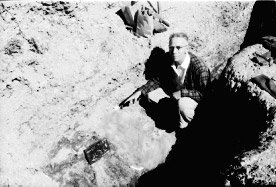Ripley P. Bullen, past Florida Museum curator of Florida Archaeology, collected information about Florida projectile points from both avocational and professional archaeologists for decades.
Timeline:
- 1957 – Museum records suggest this is when Bullen first gathered data for the projectile point classification.
- 1967 – Bullen presented first rendition of projectile point typology at a Florida Anthropological Society meeting.
- 1968 – First edition of the projectile point guide describing 43 types was published by the Florida State Museum (now Florida Museum of Natural History).
- 1975 – Second edition, basically a revision of original types and chronological distinctions as well as additions depicting 54 types was published by Kendall Books™.
- 2004 – First web page on Bullen projectile point type collection provides inventory and history by Jerald T. Milanich, Curator in Archaeology 1975-2007, now Curator Emeritus (History of the Ripley Bullen Projectile Point Typology [PDF]).
- 2005 – Isolated Finds Policy in Florida was discussed and discontinued. It is against the law for anyone to collect or remove artifacts from state or federal lands including underwater sites. For more information, visit Florida Division of Historic Resources.
- 2012 – Revised Bullen projectile point type collection expanded to
include galleries for each type and point in the collection.

Background:
Bullen’s stone tool typology was meant as a starting point to understand the variety of this type of artifact to address archaeological cultural groups through time. It is still one of the most highly used stone tool typologies for Florida. Bullen anticipated that it would be further refined and built upon through the years. Bullen’s typology was first presented in the 1960s and was reprinted in the 1970s due to high demand (Bullen 1975). In the 1990s the actual projectile point type collection was listed on the Florida Museum’s original website and a few images of selected points were displayed. The current website is the complete digital gallery of what has become the Florida Museum’s Bullen Projectile Point Type Collection. The intent of this new digital version is to provide a comparative research tool, increase access visually, and stimulate discussion and continued research of this renowned collection (e.g., Dunbar 2007; Farr 2006; Milanich 1994; Thulman 2007).
Description:
Currently, the type collection is comprised of 620 specimens. This website consists of images of 51 of the 54 types, as three do not have representative examples within the type collection (Union Side Notched, Hardee Beveled, and Broward). While Bullen lists 50 types, the Florida Archaic Stemmed points actually consist of four distinct types (Alachua, Marion, Levy, and Putnam) and the Dalton points consist of two distinct types (Nuckolls and Colbert). Bullen divided a number of types into subtypes; only the following are represented in the digital Bullen Type Collection: Bolen Beveled (5 subtypes), Bolen Plain (5 subtypes), and Duval (3 subtypes). This constitutes a total of 64 types and subtypes (See Explore the Collection by Type or Subtype). Fourteen other types were divided into subtypes by Bullen in the 1975 edition.
Chronology:
These projectile points are broadly grouped by archaeological time periods:
- Paleoindian ca. 10,000 – 9000 BCE (Clovis, Simpson, Suwannee, Union Side Notched
- Early Dalton ca. 8,000 – 7000 BCE (Bolen Beveled, Bolen Plain, Gilchrist, Greenbriar, Hardaway Side Notched, Marianna)
- Late Dalton ca. 7000 – 6000 BCE (Beaver Lake, Colbert Dalton, Nuckolls Dalton, Santa Fe, Tallahassee, Wacissa, Stanfield)
- Early Archaic ca. 6000 – 5000 BCE (Arredondo, Florida Spike, Hamilton, Hardee Beveled, Sumter, Thonotosassa, Kirk Serrated)
- Middle Archaic ca. 5000 – 3000 BCE (Florida Morrow Mountain, Savannah River, Hillsborough, Newnan)
- Late Archaic ca. 3000 – 2000 BCE(Alachua, Levy, Marion, Putnam, Culbreath, Clay)
- Transitional ca. 2000 – 500 BCE (Lafayette, Citrus, Hernando)
- Woodland (Post-Archaic Regional/Deptford/Swift Creek) ca. 500 BCE – 1250 CE (Broward, Florida Adena, Florida Copena, Gadsden, Sarasota, Taylor, Westo, Jackson, Ocala)
- Mississippian (Post-Archaic Regional; Deptford/Weeden Island/St. Johns) ca.1250 – 1600 CE (Bradford, Duval, Leon, O’Leno, Columbia)
- Alachua Tradition to Contact Period (Post-Archaic Regional; Ft. Walton/Safety Harbor/St. Johns) ca. 1250 – 1600 CE (Pinellas, Tampa, Itchetucknee).
Location:

The 30 counties where the original Bullen projectile points came from are primarily in the northern half of the state. In general, this corresponds to the natural lithic resources (e.g., chert) in the state.
Archaeological evidence supports this distribution, as South Florida sites contain limited stone tools, with shell tools predominating (e.g., Austin 1995, 1996, 1997, 2011; Austin and Estabrook 2000; Simpson 1941; Upchurch 1980; Upchurch, Strom and Nuckels 1981). Upchurch and Strom’s chert collections were donated to the Florida Museum in 1983 and another larger collection of chert from around the state was again donated by Sam Upchurch in 1993. The Upchurch Chert Type Collection is curated in the Florida Archaeology holdings of the Florida Museum.
A brief section on the commonly used terms associated with projectile points is provided (Lithic Terminology).